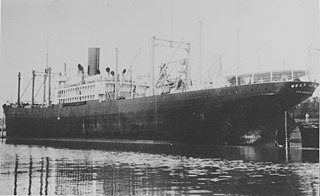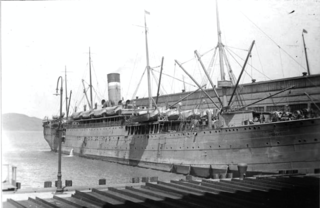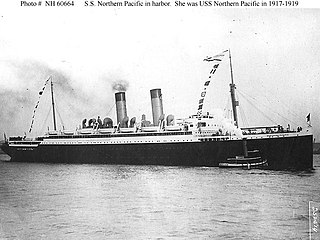
USS Badger was an auxiliary cruiser of the United States Navy, the first U.S. Navy ship named after the burrowing mammal. Badger was sold to the War Department in April 1900 to serve as the U.S. Army Transport Lawton.

USS Comfort (AH-3) was a hospital ship for the United States Navy in World War I. She was the sister ship of USS Mercy (AH-4) but the two ships were not of a ship class. Comfort was known as SS Havana in passenger service for the Ward Line, and as USAT Havana in United States Army service before her Navy service. Her name was restored to Havana in 1927, and she was renamed SS Yucatán in 1935, and SS Agwileon in 1941. In World War II, she was known as USAT Agwileon and USAHS Shamrock in service for the United States Army.

USAT Buford was a combination cargo/passenger ship, originally launched in 1890 as the SS Mississippi. She was purchased by the US Army in 1898 for transport duty in the Spanish–American War. In 1919, she was briefly transferred to the US Navy, commissioned as the USS Buford, to repatriate troops home after World War I, and then later that year returned to the Army.

The USAT Meigs was a United States Army transport ship that was built in 1921 and sunk in Darwin Harbour in the first Japanese air raid against the Australia mainland on 19 February 1942.

USAT Thomas was a United States Army transport ship purchased on 26 July 1898 for Spanish–American War service. Thomas served with the Army Transport Service (ATS) until retired in 1929.

Arizona was a record breaking British passenger liner that was the first of the Guion Line's Atlantic Greyhounds on the Liverpool-Queenstown-New York route. One nautical historian called Arizona "a souped up transatlantic hot rod." Entering service in 1879, she was the prototype for Atlantic express liners until the Inman Line introduced its twin screw City of New York in 1889. The Arizona type liner is generally considered as unsuccessful because too much was sacrificed for speed. Laid up in 1894 when Guion stopped sailings, Arizona was sold four years later and briefly employed in the Pacific until she was acquired by the US Government for service in the Spanish–American War. As the US Navy's Hancock she continued trooping through World War I, and was scrapped in 1926.

The United States Army Transport Service (ATS) was established as a sea-going transport service that was independent of the Navy Department. ATS operated army transport ships for both troop transport and cargo service between United States ports and overseas posts. This service is often confused with the Army Transportation Service, created in France in 1917 to manage American Expeditionary Forces transport. ATS was a branch of the Quartermaster Corps responsible for land and water transport, becoming a separate United States Army Transportation Corps on July 31, 1942.

Great Northern was a passenger ship built at Philadelphia by William Cramp & Sons under supervision of the Great Northern Pacific Steam Ship Company for the Spokane, Portland and Seattle Railway Company, itself a joint venture of the Great Northern Railway and Northern Pacific Railway. Great Northern, along with sister ship Northern Pacific, were built to provide a passenger and freight link by sea between the northern transcontinental rail lines via the Spokane, Portland and Seattle Railway terminal at Astoria, Oregon and San Francisco beginning in spring of 1915.

USS General Omar Bundy (AP-152) was a General G. O. Squier-class transport ship for the U.S. Navy in World War II.

USS General C. G. Morton (AP-138) was a General G. O. Squier-class transport ship for the U.S. Navy in World War II. She was named in honor of U.S. Army general Charles Gould Morton. She was transferred to the U.S. Army as USAT General C. G. Morton in 1946. On 1 March 1950 she was transferred to the Military Sea Transportation Service (MSTS) as USNS General C. G. Morton (T-AP-138). She was later sold for commercial operation under the name SS Green Wave, before being scrapped in 1980.

SS Northern Pacific was built as a passenger ship at Philadelphia by William Cramp & Sons under supervision of the Great Northern Pacific Steam Ship Company for the Spokane, Portland and Seattle Railway Company. Northern Pacific, along with sister ship Great Northern, were built to provide a passenger and freight link by sea between the Great Northern Railway Lines and Spokane, Portland and Seattle Railway terminal at Astoria, Oregon and San Francisco beginning in spring of 1915. The ship was acquired on 17 September 1917 for use as a transport ship for the United States Navy during World War I, commissioned USS Northern Pacific and later, after transfer to the United States Army, as the Army transport USAT Northern Pacific. She was destroyed by fire in 1922.

SS Edenton was a steel-hulled cargo ship built in 1918 for the United States Shipping Board as part of the Board's World War I emergency shipbuilding program.

USAT McClellan was a United States Army transport ship that saw service during the Spanish–American War and World War I. She also participated in the occupation of Veracruz in 1914.

USC&GS Romblon was a steamer, owned by the Philippine Insular Government, that served exclusively in the Philippines. The ship was purchased by the Philippine Bureau of Coast Guard and Transportation to support both government logistical and administrative travel needs as well as the usual functions of a coast guard vessel. The vessel was transferred to the United States Coast and Geodetic Survey serving as a survey ship from 1905 to 1932. Romblon and Marinduque were sister ships, both built in Japan.

The first USC&GSS Pathfinder, also noted in some NOAA histories as "old Pathfinder", was a United States Coast and Geodetic Survey ship in service from 1899 to 1941, when she was beached in sinking condition on January 30, 1942, after 40 years service in the Philippines.

Don Esteban, delivered in 1936, was the first and smaller of two Krupp built motor ships of the De La Rama Steamship Company, Iloilo, Philippines in inter-island service. The ship was under a bareboat charter by the United States Army as a transport on 30 October 1941 for use in pre positioning U.S. Army Air Corps (USAAC) fuel and munitions in the southern Philippines, Netherlands East Indies, Singapore and Australia. After the Japanese invasion of the Philippines she evacuated personnel from the Army headquarters, including General MacArthur, from Manila to Corregidor on Christmas Eve, 1941. The ship was lost off Mindoro on 2 March 1942 while continuing its supply missions.

SS Barbara Olson was a cargo ship built in Wisconsin in 1918 as the SS Corrales. Barbara Olson was able to escape an attack off the coast of California in the early days of World War II. The Barbara Olson was built under a United States Shipping Board (USSB) contract in 1918 as the SS Corrales and renamed in 1940. On July 25, 1942, she was chartered by the US Army to transport supplies to the Territory of Hawaii as the USAT Barbara Olson for World War II. On January 14, 1946, her Army service ended. In 1964 she was run aground four miles (6.4 km) north of Pimentel, Peru and declared a total loss.

The steamship Manitoba was steel-hulled freighter built for the Atlantic Transport Line in 1892. She carried live cattle and frozen beef from the United States to England until the advent of the Spanish-American War. In 1898 she was purchased by the United States Army for use as an ocean-going troopship. During the Spanish-American War she carried troops and supplies between the U.S. mainland, Cuba, and Puerto Rico.

The steamship Massachusetts was steel-hulled freighter built for the Atlantic Transport Line in 1891. She carried live cattle and frozen beef from the United States to England until the advent of the Spanish–American War. In 1898 she was purchased by the United States Army for use as an ocean-going troopship. During the Spanish–American War she carried troops and supplies between the U.S. mainland, Cuba, and Puerto Rico.





















